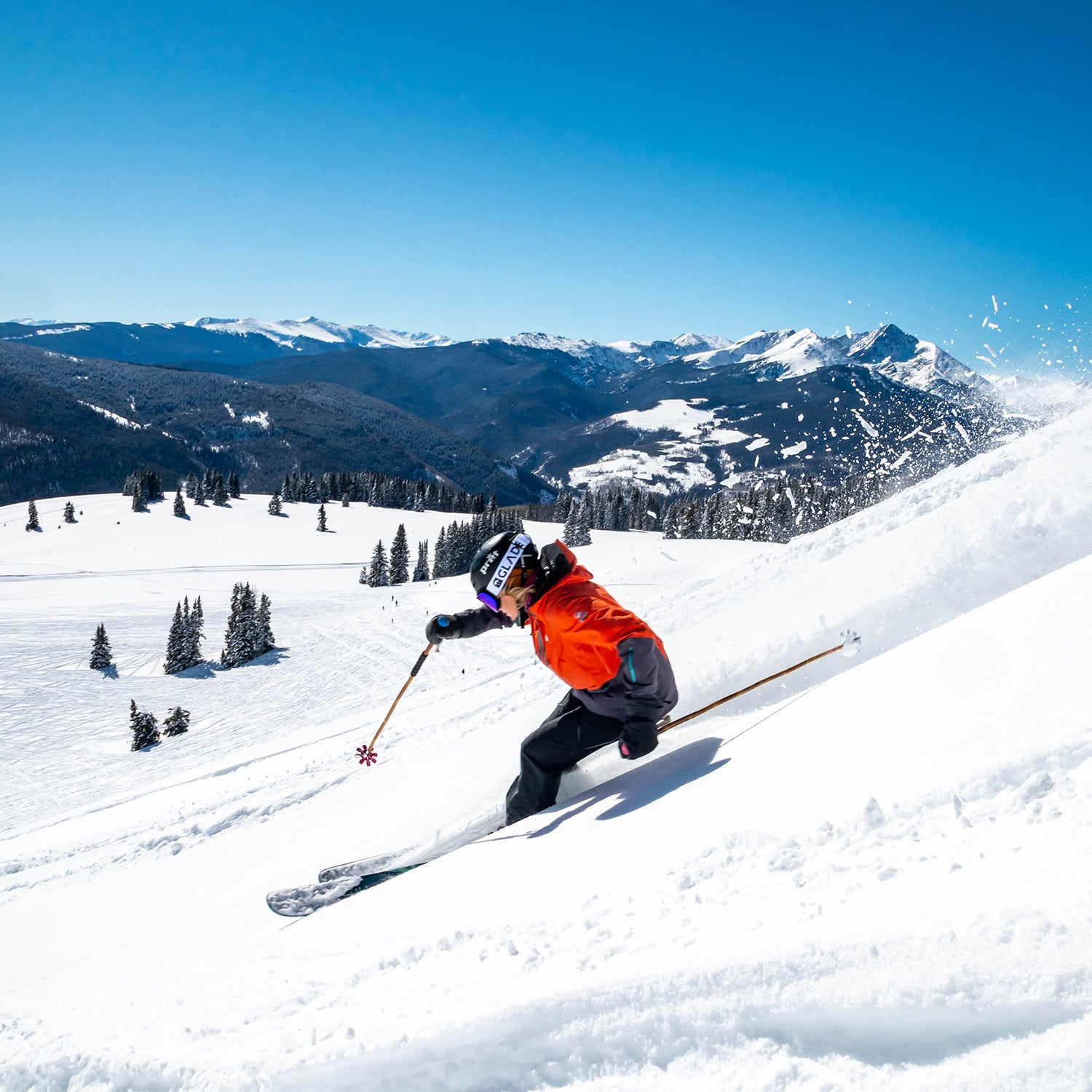With waist dimensions of 95 to 100 millimeters underfoot, our all-mountain skis are the most versatile boards you can step into. Like to mix up your day carving groomed snow, navigating bumps, ripping chalky snow in the trees, and searching out old powder? Start here. These skis are made for skiing 50 percent on trail and 50 percent off trail.
At our annual ski test, we ride 15 to 20 new all-mountain skis to determine which ones will make the cut for print. Only one unisex and one women’s model wind up in the magazine, but there are always many more that come very close. Here’s the best of the rest.
Unisex All-Mountain Skis
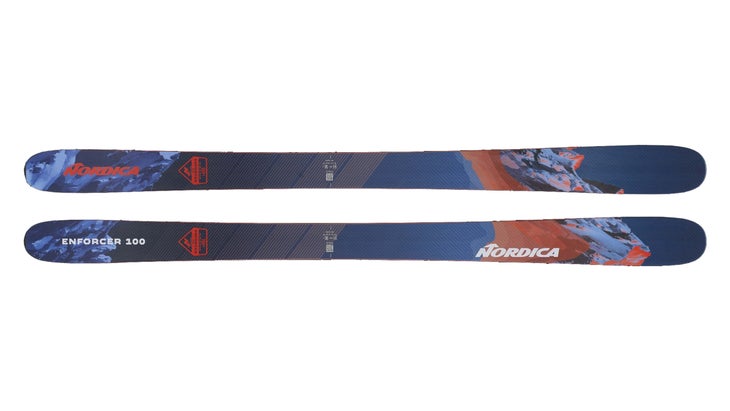
Nordica Enforcer 100 ($850)
Dimensions: 133/100/121
Last year, Nordica updated the Enforcer 100 with a new tip construction and carbon chassis, which cemented its spot as a constant podium finisher. It’s still the benchmark for our take on an all mountain ski. “You can carve turns at eye-watering speeds on all manner of hardpack,” said a tester. “But off-trail it transforms itself and lets you slink through jumbled terrain, third-buckle-deep powder, and trees.” It’s hard to pin that versatility on just one feature. Like all great skis, it’s the parts that create the whole: two full sheets of carbon-backed titanal that sandwich a wood core. A new profile yields a deep flex that’s progressive but approachable. Just the right amount of torsional rigidity lets it bite deeply on edge but release in a smear. It’s damp without being dead. And there’s enough rocker for real-world resort skiing without sacrificing edge contact.
Gripe: Nordica builds its skis for people that like to ski fast. The Enforcer 100 skis fine at a jog, but you’re missing out if you don’t grab some throttle.
Like: “Considering how stable this ski is, it’s lively as hell,” said one tester who ranked it with the and for hauling ass. “A true on-trail, off-trail tool.”
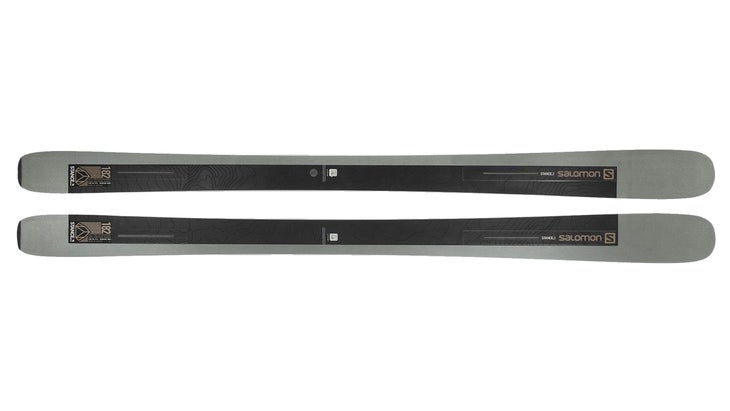
Salomon Stance 96 ($850)
Dimensions: 132/96/114
Salomon is famous for its loose and surfy of all mountain skis, but has decided to show the ski world that it can build burly skis too. The Stance features two full sheets of titanal, a powered up wood core thanks to a thicker profile, and vertical sidewalls—the hallmarks of a bomber ski. Add in a flex profile that’s stiffer than most of the skis in the category, and a 20-meter turn radius built for sweeping arcs, and you get a mid-fat ski with legit frontside chops. “This ski wails!” said a tester. “It rides like a fat carving board when you want it to, but you can just as easily scrub speed and bang out short swing turns too. The balance of flex and sidecut is perfect.” So who should buy it? If you spend 85 percent of your time arcing turns (as opposed to slashing around in a more upright style) but still want some width for those six-inch dumps, you should start here. Just don’t expect it to ski like a QST. There’s no overlap. The Stance is the hardest charging ski in the category.
Gripe: More of a warning than a whine, but this style of skiing isn’t for everyone. If you don’t know how to lay a ski over, you might want something looser.
Like: “At first it looks and feels like an oversized carving ski, but there’s way more versatility here,” said a tester. “You can scrub it around off-trail or take it in the trees too.”
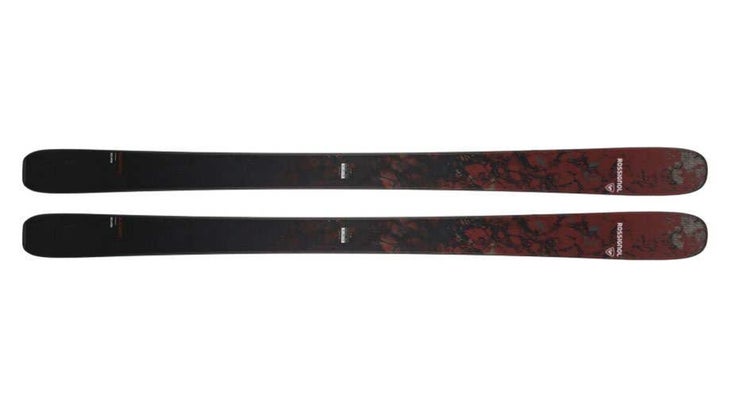
Rossignol Blackops Escaper ($700)
Dimensions: 128/94/118
The top four skis in the All Mountain category sport two sheets of titanal for maximum stability and torsional strength. This Blackops Escaper does not, but it’s still a hoot to rip around on. “It was my top-ranked ski for off-trail skiing,” said a tester. “You can smear them around in bumps and old powder at the edge of trails. And on perfect corduroy they carve it up.” That off-trail performance speaks to the positioning of this ski. It’s built to explore off-piste or get mounted with a hybrid resort/backcountry binding to serve as a low-snow touring ski. But back inbounds on soft to medium snow it’s plenty capable. The brand’s hallmark Air Tips—an ABS-resin honeycomb—keep the swing weight low for pivot turns, and viscous (rubber) layers add damping without the weight of metal. It’s not ideally suited to man-made white ice or refrozen early morning snow, but it’s plenty burly for many skiers in Colorado and Utah. “For a ski without metal it just rips,” said a tester. “You can ski it like a racer on fresh groomers, or slink through bumps, or blow-up pow.” So who should buy the Escaper? The category is for skiers that ski equal parts on-piste to off-piste. The Escaper is a 70 percent off-trail, fall-line ski.
Gripe: If you ski hardpack all the time at high speeds, you’d be better off on a ski with alloy.
Like: Damp, silky, and quick, it’s built for exploring.
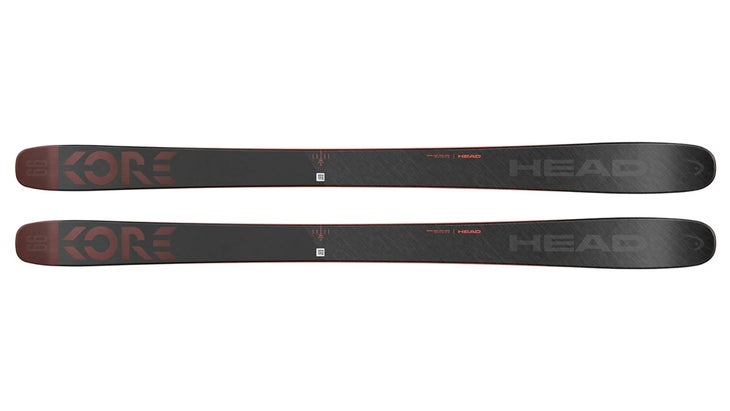
Head Kore 99 ($800)
Dimensions: 134/99/120
Head took the out of the Kore 99. The result? A livelier ride quality. “It’s still damp and powerful, like we’ve come to expect from Kore skis, but the 99 was far more sprightly,” said a tester. If you haven’t skied a Kore, they’re worth checking out. There are now several contenders for the “we don’t need no stinkin’ metal” throne (see the Rossi Escaper and Ripstick 96 BE in this category). But to date, nobody has made skis this damp and silky without alloy. The Kore ride quality is unique. We’ve always related it to 29-inch wheels with low pressure rubber on a mountain bike: you don’t always feel the advantage of an absorbent ride, but you know it’s there. With the Kore 99s, you get impressive hold and stability on edge, from an undemanding ski that’s more smooth than it is dynamic. Credit must go to Head’s use of graphene, a space-age material capable of mimicking some of the properties of metal. A caruba wood core keeps it so light that the 99 could easily be a daily backcountry ski.
Gripe: In the backcountry and off-trail inbounds we love this ski’s predictability over edge-to-edge spirit, but back on the groomers we like more zip.
Like: “Big smear turns and a nice comfortable flex,” said a tester. “They float really well and you can pivot turn them effortlessly off-trail.”
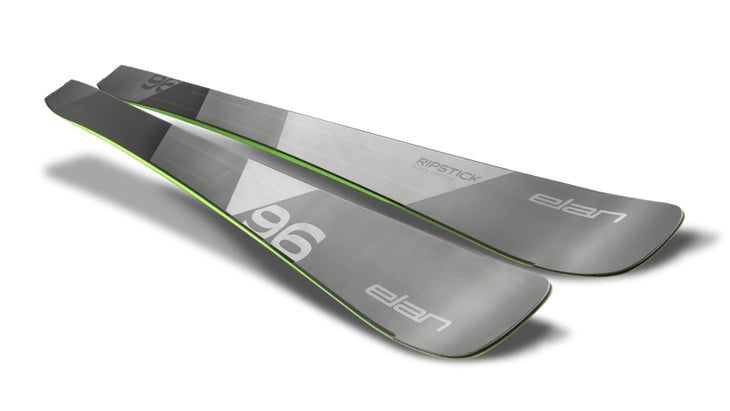
Elan Ripstick 96 Black Edition ($1,000)
Dimensions: 136/96/110
We’ve loved the original Ripstick 96 for years. But we always felt that the ski lacked a bit of feedback (kinetic energy) as you released the turn. The Black Edition is Elan’s fix. Here, carbon above the inside edges creates just a bit more bite and torsional rigidity to energize the ski. “Of the skis without metal,” said a tester, “the 96 BE is the most lively. It’s just as damp and stable, but when you push it into high edge angles on groomed snow it feels like it’s pushing back.” Take this as testament that, to date, Elan has the best handle on how to incorporate carbon without overdoing it. And that last point is crucial. Over-apply or miss-apply carbon, even by a dozen grams or a few millimeters, and skis get nervous. Elan has figured out how to go subtle. Credit its proprietary carbon rods—pencil thin tubes embedded in the ski to help it contour the snow instead of chattering—and a dedication to building specific left and right skis. The build means Elan is only infusing the 96 with the carbon it needs for torsional stiffness, but not to the point of nervousness.
Gripe: Even the souped-up Black Edition skis get a touch skittish at highway speeds.
Like: “The asymmetrical build with the extra rocker on the outside edges and the reinforced inner edges makes for an intuitive ride that can best be described as autopilot,” said a tester. “You can rip with very little effort.”
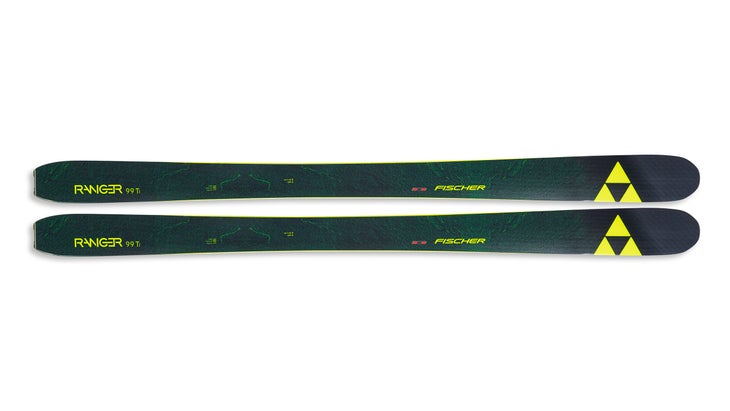
Fischer Ranger 99 Ti ($799)
Dimensions: 130/97/121
We’re big Fischer fans. The Austrian company isn’t afraid to experiment with new materials and construction. In the Ranger 99 Ti that innovation includes a “Carbon Nose” to reduce swing weight and “Aaeroshaping” to reduce the ski’s mass, and therefore drag, in deep snow. At the same time, Fischer doesn’t hesitate to go traditional with the sidewalls (vertical for edging power) or metal (two sheets of titanal for stability). On the test hill, only the Salomon Stance outperformed the 99 for carving turns on machine-groomed snow. But the Ranger 99 Ti is far more versatile off-trail. “The coolest thing about these skis is the ability for them to knife through crud and chopped snow and sustain an arc,” said a tester. That low profile shaped shovel really works. So who should buy the Ranger 99 Ti? For starters, anybody with a technical skiing background that’s looking to power up a ski from tip to tail and achieve high-edge angles on groomed snow. But because of that low swing weight, subtle rocker, and overall weight savings (Fischer mills air channels into its cores), the 99 is nearly as adept off-trail.
Gripe: Mixing up the turn shape off-trail is easy, but once it’s railing on corduroy it wants to stay there.
Like: “The Fischer rewards aggressive skiers,” said a tester. “You can sluff it around off-trail, but when it’s time to charge it comes to life.”
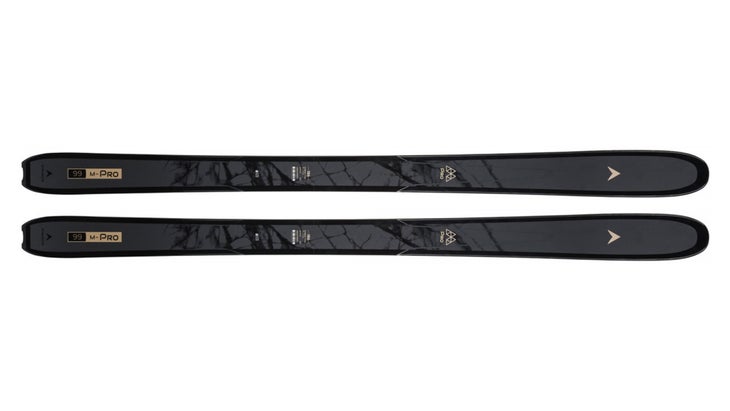
Dynastar M-Pro 99 ($800)
Dimensions: 127/99/117
In 2020, we had soft snow at our Steamboat tests and this Dynastar, with its hybrid polyurethane-wood core and elongated but subtle rocker, was a standout for its loose and surfy feel and silky ride quality. This year, with truly hard snow topped with death cookies, the easy and light skiing feel of the 99 was a mild demerit. Those are the types of distinctions consumers should be thinking about as they shop for skis. The M-Pro excels on medium to soft snow. “This was my top off-trail ski of the day,” said our test director. “I love that silky feel of Dynastar’s hybrid cores. They seem to contour the terrain better while at the same time shaving just enough weight for slashed and smeared turns.” That’s the off-piste stuff, but as adept as the M Pro is there, it’s also no slacker on machine-groomed surfaces. Full length vertical sidewalls, a unique application of titanal (rather than full sheets, strips of it extend from beneath the bindings) and a smooth transition to the sidecut in the tail means you can set them on edge and they’ll hang on.
Gripe: This may or may not have to do with the PU in the cores, but the ski gets a hair nervous when you’re hitting chunks on groomers.
Like: If you live out West and ski off-trail 65 percent of the time, you’ll have more fun on this all mountain freerider. Said a tester: “Killer float, tons of rocker, easy to pivot, and a damp but easy character.”
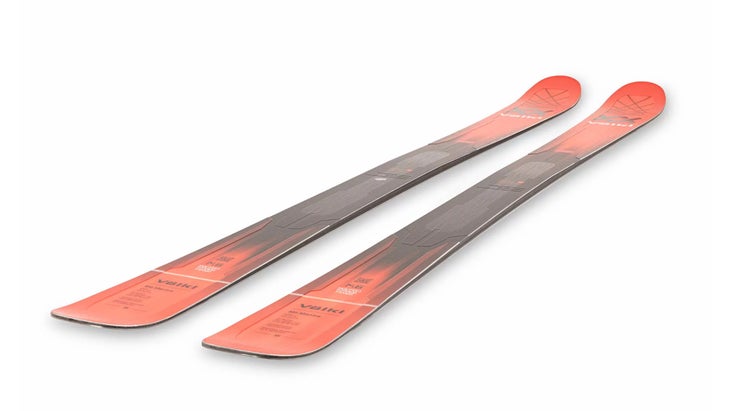
Völkl M6 Mantra ($825)
Dimensions: 135/96/119
If the Dynastar M Pro 99 is the most powder-focused ski in the category, then the new Völkl M6 is the most groomer-centric tool. “Best edgehold of the day,” said a tester. “On groomed snow it was perhaps the easiest ski to get on edge. There’s enough torsion here not just for hard snow skiing, but for dynamic energy return too. It rips with confidence.” That performance comes from a new multi-radius sidecut that gets quite short underfoot (19 meters) but doesn’t demand that you ski like a racer to enjoy it. Instead of “shin it to win it” pressure on the forebody, you just sink into the belly of the arc naturally. Stand up and pivot your turns in bumps and crud, though, and the M6 feels like you’re on a longer radius ski, meaning it remains plenty agile without feeling hooky. Add that sidecut to a ski reinforced strategically around the perimeter with titanal and again at the tip with a web of carbon, and you get a precise carving machine that’s also capable of fun off-trail skiing. We’d run it on groomers, alpine chalk, and spring corn 70 percent of the time.
Gripe: We’ve dinged Völkl’s titanal frame skis in the past for delivering a “glassy” or “hollow” ride quality that can be disconcerting at speeds, even if the skis don’t really waver. In the M6, Völkl nearly cured this problem, but we were still picking up high frequency vibrations.
Like: The M6 Mantra gets back to that classic Völkl groomer feel, but with a modern sidecut that lets you mix up the turn shapes.”
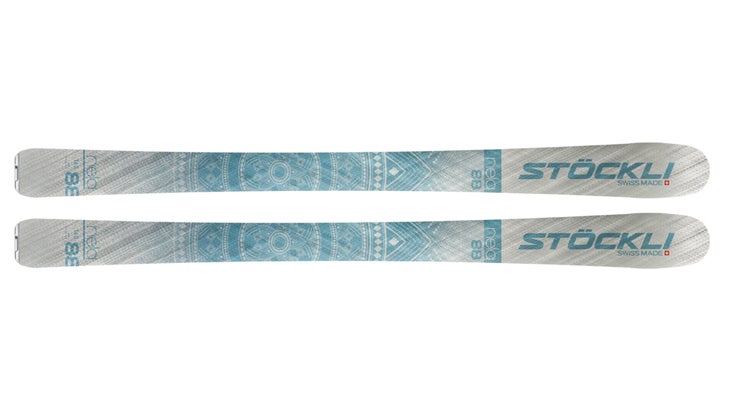
Scott Slight 100 ($850)
Dimensions: 139/100/129
The Slight 100 isn’t technically a backcountry ski—it was designed to cross into that world from the resort—but if we were skiing 7,000 vertical feet of corn snow on a PNW volcano, this is the ski we’d want under our feet. It’s so easy to tip into a smooth, round carve that we’d pilot it in soft AT boots. The resulting arcs are so predictable and effortless that it takes a layer of complexity out of backcountry skiing. Back inbounds, the Slight 100 excels on moderately angled groomers with freshly tilled corduroy. “These were the easiest carvers of the day,” said three testers. “You can make big turns or short swings with subtle changes in pressure, and when you want to break free from the carve you can throw them sideways. Ski tourers or advanced resort skiers that keep their speed in check will dig them.” And that’s who we think should buy these skis. The Slights weighed in at 1,700 grams in a 178. And while they aren’t the burliest skis we tested, they make confident carves on hard snow if you drop speed. Credit for that in-bounds, out-of-bounds versatility comes from Scott’s robust but tempered use of carbon fiber—there’s a weave of carbon paired with dampening aramid fibers in lieu of metal.
Gripe: The Slight was not intended to be the stoutest ski on the hill, and it’s not.
Like: Said a tester: “If you live to make metronome turns at moderate speeds inbounds and out, the Slight is a sure thing.”
Women’s All-Mountain Skis
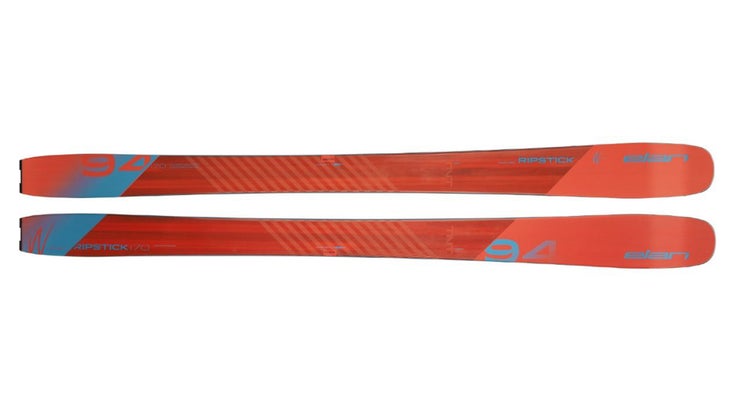
Elan Ripstick 94 W ($750)
Dimensions: 136/94/110
One of the most technically advanced skis on the market, the Ripstick 94 W features thin carbon tubes embedded in a lightweight wood core to give the ski a zippy feel while allowing it to contour the terrain. Up in the tip, advanced composites sit in cutaways in the wood core to boost damping while shaving swing weight. In the belly of the ski, in addition to the carbon tubes, strips of carbon fiber reinforce the inside edges for extra torsion and bite. Even the shape of the ski is unique: the outside edges (the skis are dedicated left and right) are kicked up with more rocker for a loose feel in soft snow, while the inside edges, which are easier to control, get more camber and edge contact. On the hill, they ski like nothing else on the market. “It’s nearly impossible to catch an edge,” said a tester, “but when you tip them into a carve they hold, letting you leave trenches. Head into the crud, though, and you can smear your turns.” The versatility comes from the 94 W’s deep and easy progressive flex that allows you to butter the ski around at slow speeds (like when you’re skiing with the kids) or push it as you advance your skills.
Gripe: At the highest speeds, skis without metal in them tend to get nervous even if they’re still tracking.
Like: Said a tester: “They ski so intuitively that they feel like an extension of the body.”
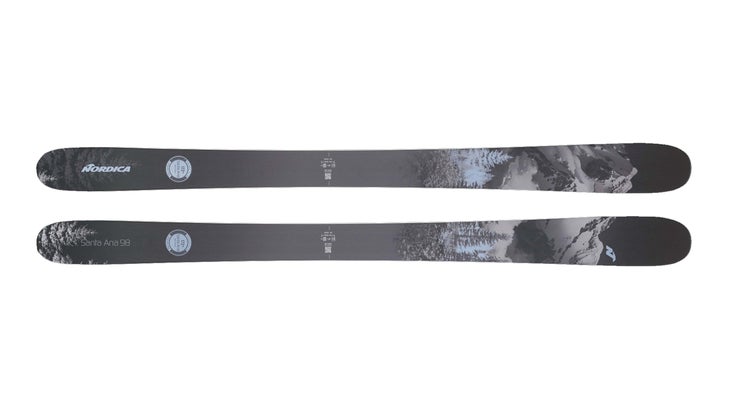
Nordica Santa Ana 98 ($800)
Dimensions: 132/98/120
This one came close to winning its category, but then again the most versatile ski isn’t always the one that comes out on top—and that’s exactly what the Santa Ana 98 is. It’s our top pick for a true 50 percent on-trail, 50 percent off-trail ski back East on bigger hills like Killington or out West in places like Summit County, Colorado. It’s not especially narrow for carving, or fat for powder. Rather, it’s the Goldilocks width, capable of arcing turns on hardpack or floating turns in resort powder. “You can carve or smear ’em at super slow speeds” said our women’s test director, “or you can dial them up and just charge. An intermediate could ski them and end up an expert a season later.” The performance comes from Nordica’s unique take on ski design. Instead of making a hundred specialized skis, they favor versatility. And to get there, they don’t chase trends. Take weight savings for example. With the Santa Ana, Nordica saved weight in the wood core by incorporating lighter species, so that they could strategically add vibration-eating metal back into the ski. The result? A model that doesn’t ski heavy, but is stable and confidence inspiring on edge. “Damn, this ski is super strong, but it skis easy too,” said a tester.
Gripe: They aren’t as playful as some would like. If you want a surfier ride, step up to the Santa Ana 104 Free.
Like: Even on true hardpack days you won’t feel the need for a dedicated carving ski. The 98s slice it up.
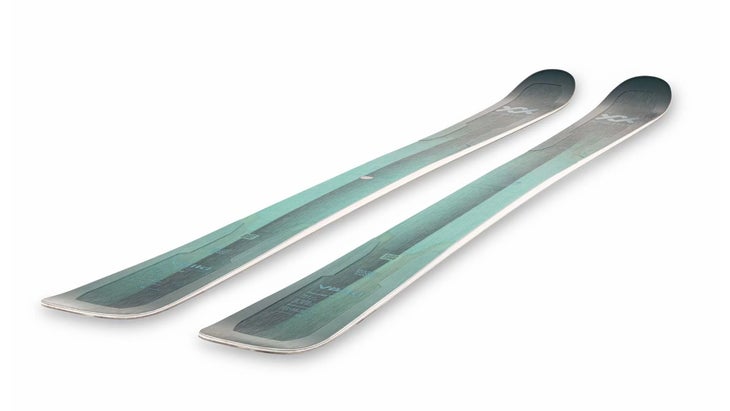
Völkl Secret 96 W ($825)
Dimensions: 135/96/119
This brand new Secret crushed its competition. “Makes any kind of turn at any speed,” said a tester. “But it’s even easier to control than the old version. All that and the 96 offers killer edgehold and top stability.” Credit for improvements in ease of use and power come from the re-tuning of Völkl’s titanal frame construction, which places metal over the edges for power, but avoids full sheets of alloy to save weight. In the smaller women’s lengths, that titanal frame is tuned for lighter-weight skiers. A new web of carbon fiber in the tip makes turn initiation both more positive (the edges engage more seamlessly) and less vibration inducing (the carbon ties the tip to the rest of the ski better for a smoother ride). So who should buy it? As with its unisex counterpart, the M6 Mantra, this Völkl is built for people that know how to ski from tip to tail and execute a clean arc—or those who aspire to that goal. The Secret 96 had the highest carving scores in the category. You can, however, take it off-trail and have a good time, you just need to keep it edging—despite the width, this is not a powder ski, it’s a true all mountain tool for the crowd that likes to lay a ski over.
Gripe: This is a precise ski, which is positive until you want to smear turns in grabby crud. That requires attention.
Like: Back on the groomed snow it’s “crisp, lively, light, fast edge-to-edge, and seems to know where and when you want to turn,” said a tester. “I would ski it on-trail 70 percent of the time.”
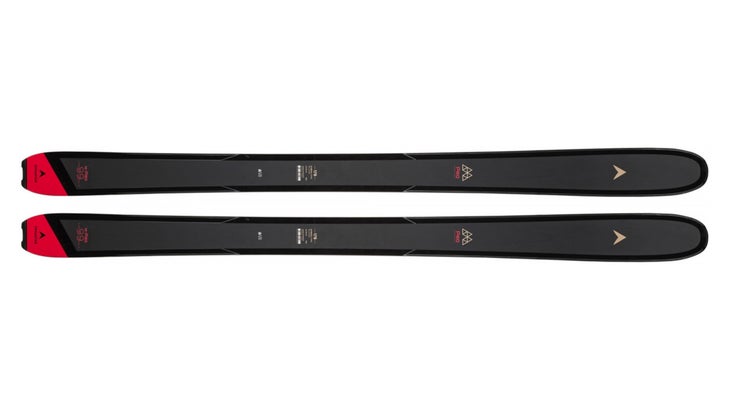
Dynastar M-Pro 99 W ($800)
Dimensions: 127/99/117
It scored well in our all mountain category, but to be clear, the M Pro W is designed to excel on soft snow above all else. Think first tracks after a six inch storm in the bowls, or a day spent poking around in the trees for powder scraps, or even a morning ripping perfect corduroy. At those tasks, the 99 was best in class. “This ski is so smooth it butters and floats off-trail, but you can flat out charge on it too,” said a tester. That makes sense: the M Pro skis feature unique hybrid cores crafted from a blend of lightweight polyurethane and energizing, long-lasting poplar. The result: a damp, silky ride. They seem to contour the terrain and at the same time allow for a deep consistent flex. Tip and tail rocker extends deep into the ski, but the splay (height of rocker) is subtle, so the ski planes on top of new snow instead of plowing through it. Back on groomed runs, the M Pro is more of a mixed bag. In 2020, we loved it on soft corduroy. At our 2021 test, we got legit melt/freeze hardpack with high moisture content, and the ski chattered a bit in those conditions. Even on that frozen snot, it cut a clean arc on edge. There’s strategically placed titanal for torsional rigidity—it extends fore and aft of the bindings.
Gripe: It skis light on boilerplate.
Like: “Off-trail you can pivot, smear, or send it,” said a tester.
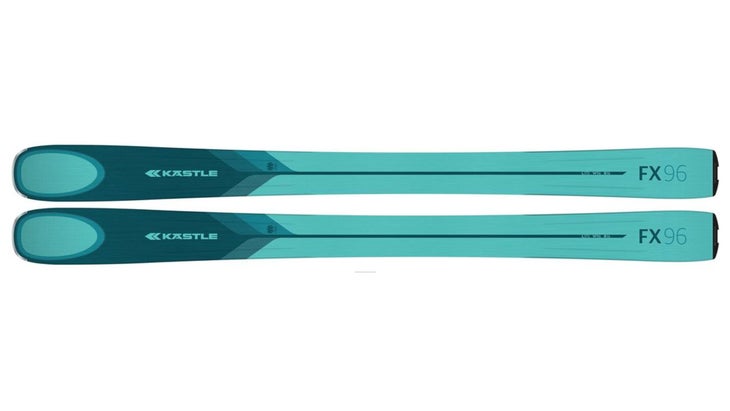
Kästle FX96 W ($849)
Dimensions: 133/96/119
Looking for a true crossover ski capable of inbounds ripping and out-of-bounds touring? That was the intent behind the easy skiing FX96. There’s no metal here. Instead, an inner torsion box (wood fully wrapped in fiberglass) is inlaid into the surrounding wood core. The design delivers the torsional strength of metal layers, without the weight penalty. On the test hill at Steamboat, the FX96 surprised testers used to ultra burly Kästles of old. “This is easily the mellowest Kästle I’ve ever skied,” said one. “At normal speeds, it’s smooth, damp, light, and easy.” So who should buy a set? If you ski inbounds and like to keep your speed in check, the 96 will make short arcs all day long (16 meter radius in the 172). On the other hand, if you’re an occasional out-the-gate backcountry skier and you’re looking for a mid-fat plank to mount a hybrid AT/Alpine binding to, the 96 is ideally suited.
Gripe: On hard snow at high speeds, torsion box construction—even scaled down as in this ski—can result in a “glassy” or “tinny” feel on chattery snow. We experienced that high frequency vibration here, even if the ski didn’t noticeably chatter.
Like: In soft snow it really impressed: “Wow, such a buttery and consistent feel in chopped-up powder and old crud,” said a tester. “It instills confidence.”

Stöckli Nela 88 ($999)
Dimensions: 127/88/113
By North American standards, the Nela 88 is an all mountain frontside ski with a width better suited to ripping turns on groomers 70 percent of the time. But to the Swiss, the 88 is a true on-trail/off-trail weapon. So how did it fare? Quite well, actually. We had hard and fast conditions in Steamboat (a rarity there), and the svelte but stout Nela 88 was well suited to the snowpack. “Holy shit, I loved this ski today,” said a tester who arcs short swing turns in the fall line. “It’s stable as hell, but not punishing at all. It engages with knife-like precision, but it’s subtle and buttery too. You can ski it slow and easy, or you can jump on it and lay the turns way over.” Stöckli used to be famous for madly powered-up skis that required technical training and off-season quad work to pilot. But like the rest of the ski industry, the new Nela 88s offer accommodating flexes (deep and easy) that an intermediate can enjoy. You can scrub speed or wash turns in a pinch. Put that same ski on the feet of an expert though, and the deep flex allows for big, deep arcs.
Gripe: This is only an all mountain ski at certain areas back East, in the Midwest, and depending on the hill, parts of Colorado. It’s not quite fat enough for the broader North American market.
Like: “It’s not heavy at all,” said a tester, “but when you’re going fast it skis like a heavier ski—the edgehold is astounding and the stability doesn’t waiver.”
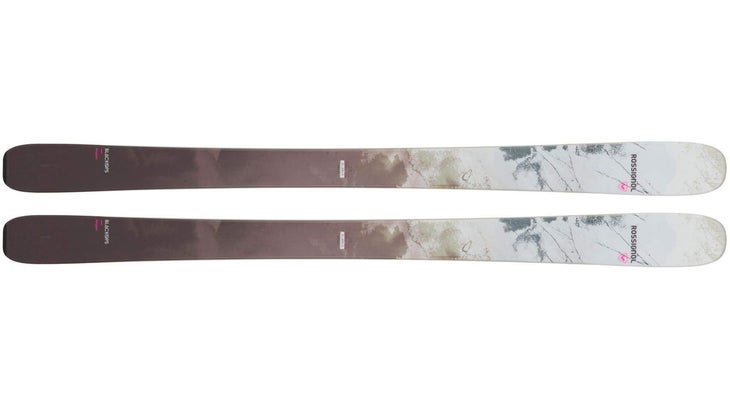
Rossignol Stargazer ($700)
Dimensions: 127/94/117
Rossignol says the Stargazer lets you, “Answer the call of first tracks.” We’d agree with that assessment. This is a lightweight (no alloy), smartly rockered ski built more for off-trail exploration than linked turns on groomers. By design Rossignol says the Stargazer features a “lower pop factor,” meaning it favors contouring the terrain more than it does delivering a ton of rebound. That smooth ride quality, paired with just the right amount of rocker and tips built from a lightweight honeycomb polymer, make the Stargazer effortless to pivot turn, smear on steep faces, or slink through the trees. “This was by far the most playful ski of the day for me,” said a tester, “but it’s by no means a liability on hard snow. You can crank out medium-radius turns all day.” Again, in modern ski construction it’s hard to point to any one thing for that versatile performance, but because Rossignol got the flex pattern right, a huge range of skiers with a huge range of styles can enjoy it. A layer of viscous, rubber material eats up vibration in lieu of metal.
Gripe: A few testers thought the ski wandered a bit at top speeds.
Like: We’d ski these like we ski an all mountain powder model—off-trail 70 percent of the time. The Stargazer is wide enough to float small- to average-sized women in all but the deepest of days, and they’re so nimble they excel in chutes and hike-to steeps, too.
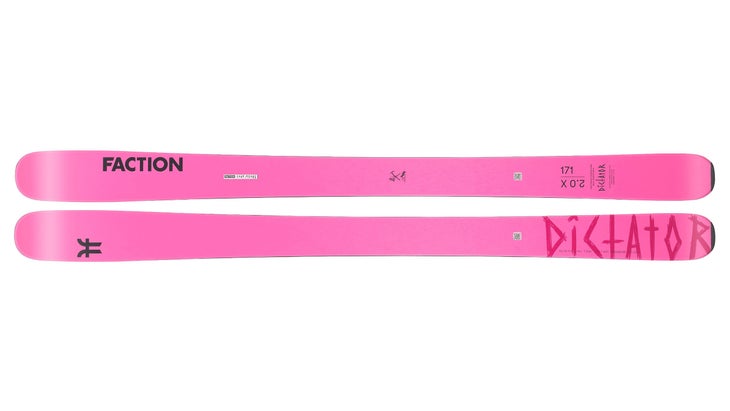
Faction Dictator 2.0X ($779)
Dimensions: 127/96/117
As ski designers focus on creating balanced skis that all sorts of body types and ability levels can rip on, it’s getting hard to tell the difference between unisex skis and women-specific skis: skis don’t know or care who’s standing on them. That’s relevant here, because the Dictator 2.0X is the same ski as the unisex Dictator 2.0. The only difference is cosmetic. That means women buyers get the same lightweight paulownia wood core backed by two sheets of titanal as the men do. The key, as always, is to buy the right length to tap into that flex. “Super stable blasting through crud or straight lining cat roads,” said a tester. “It skis like an all mountain powder ski built for charging off-trail. But you can pivot and smear it too. I don’t ski a ton of groomers. This would be my go-to resort ski for anything but the big and deep days.” Now back to that flex. The 2.0X favors skiers of all sizes as long as they like speed. It takes some g-forces to really bring it to life.
Gripe: It can take some extra input to get them to link carved turns on groomed snow. In keeping with Faction’s worldview, the 2.0Xs excel off-trail.
Like: “This is one stable ski,” said a tester. “I would love to be blasting down a bowl on windbuff on them. They charge off-trail. The tip is unwavering.”
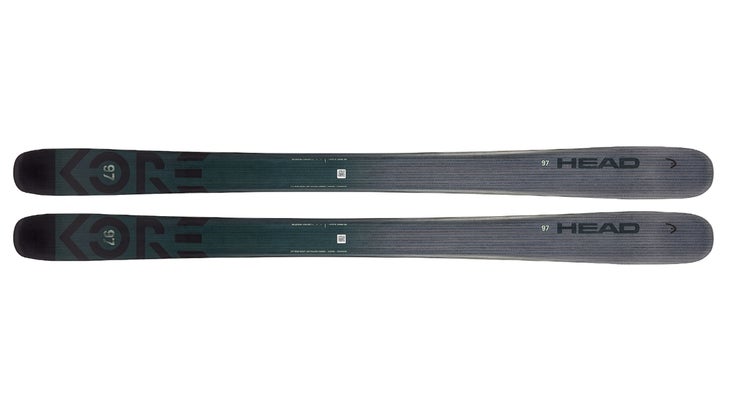
Head Kore 97 W ($800)
Dimensions: 131/97/118
Head reinvented its Kore line of skis, and the all-new Kore 97 W is a standout. It’s just as light as ever, but in pursuit of a livelier ride quality, Head ditched the inserts of Koroyd of years past in favor of some carbon above and below the core. What feels unchanged is the edgehold; all the Kore skis grip with eerie precision. The skis are so lightweight that you feel like you need to actively control the edges—but you don’t. “Turns just happen with these Kores,” said a tester. “They just sink into a medium radius arc without much input. They would be super confidence inspiring for intermediate and advanced skiers.” Damp but light is hard to come by. We’re convinced that Head’s success comes down to micro applications of , the lightest and strongest material known to science. If you’re looking for a lightweight plank that makes skiing easy, the 97 W is an easy choice. The flex profile of the caruba and poplar wood core is also incredibly inviting. A less skilled skier can make mistakes on the 97 W, but an expert can get it arcing from tip to tail.
Gripe: We were hoping for a bit more life out of the new Kores when they dumped Koroyd for carbon. The skis still feel a touch too damp to us.
Like: The amount of rocker in the tip is spot-on for the all mountain category. The rocker to helps the ski plane and ease turn initiation, and doesn’t act like a plow. Head nailed the shaping.
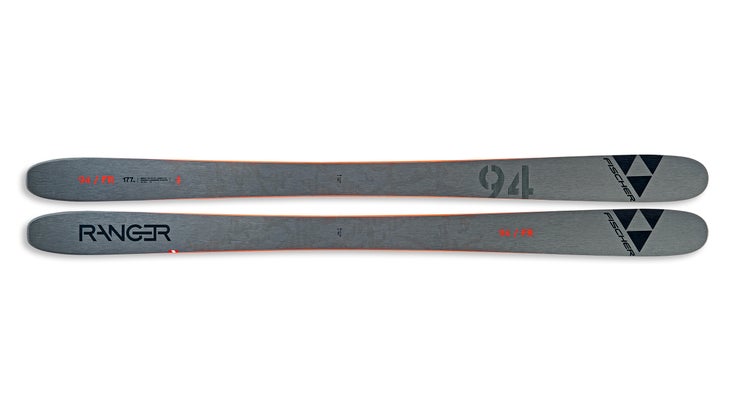
Fischer Ranger 94 FR ($699)
Dimensions: 126-92-117
Here’s another unisex ski that—no surprise—rips equally well for men and women. A twin tip with a carbon nose to reduce swing weight, the 94 FR boasts a wood core reinforced with carbon and two sheets of titanal. But it’s no heavyweight. Thanks to all that carbon, it weighs 1,850 grams per ski, light enough to mount with a hybrid binding like the Salomon Shift, Marker Duke PT, or CAST system. And don’t let the twin tip fool you. The 94 FR is a directional all mountain ski that’s truly up to the challenge of chunky groomers and chalky chutes. “Forgiving off-trail and solid back on, it favors big sweeping GS turns,” said a tester. “Off-trail there’s just enough rocker to handle piles of harbor chop and let you smear turns in the trees. I’d ski it most days when it hasn’t dumped for a while, but the off-piste stuff is still soft.” Built down to a 153-centimeter, there’s a length and a flex for all body types (except large human beings—there’s no 195).
Gripe: On paper the 94 FR sports a 17-meter turn radius. In reality it’s more stretched out than that. That’s a bonus in weird snow off-trail, but it demands a bit more muscle back on piste.
Like: Because Fischer didn’t take the metal out of the ski to meet some weird standard for women’s specific skis, the 94 FR was the most stable ski of the category.


